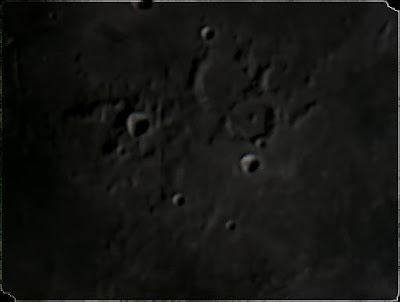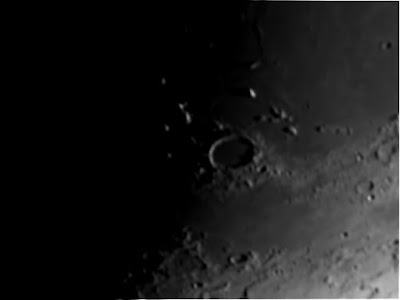La Asociación Entrerriana de Astronomía (AEA) y la Liga
Iberoamericana de Astronomía (LIADA) invitan al I Encuentro de Astronomía
Lunar, a realizarse el 7 de diciembre de 2015 a las 18 hs. en el Observatorio de
la AEA, Escuela Alberdi, Oro Verde:
sábado, 28 de noviembre de 2015
sábado, 14 de noviembre de 2015
LOS OBSERVADORES LUNARES DE LA ASOCIACIÓN ENTRERRIANA DE ASTRONOMÍA EN LOS NÚMEROS DE NOVIEMBRE DE “THE LUNAR OBSERVER” (ALPO) Y “LUNAR SECTION CIRCULAR” (BAA).
A
pesar de tener una primavera de cielos casi siempre nublados, los observadores
lunares de la Asociación Entrerrianala Asociation of lunar and
planetary observers” (ALPO).
Aparecimos
en la sección bimestral “Focus On”, que hace un análisis de un accidente lunar
en particular, esta vez el cráter Deslandres (pág.8).
También
aparecimos en la Sección
“Lunar Topographical Studies” (págs.14/15), con observaciones de Deslandres,
Mare Nubium, Pallas y Plato (las imágenes de éstas dos últimos fueron incluidas
entre las mejores fotografías).
En
la sección del “Lunar Geological Change Detection Program” (pág.19) se informa
que se utilizaron nuestras observaciones de Deslandres, Mare Crisium, Mare
Nectaris, Plato, Proclus, Alphonsus, Copernicus, Aristarchus y Tycho. Se hizo
especial referencia a la imagen que obtuvimos de Plato el 6-9-2015 y de cómo se
utilizó para cotejar con un reporte de un Fenómeno Lunar Transitorio de 1916
(pág. 20).
En la sección de dedicada al “Lunar Geological Change Detection Program” de la “Lunar Section
Circular” de la British Astronomical9 a 11).
Para
quienes quieran leer ambas revistas:
The Lunar Observer (ALPO):
http://alpo-astronomy.org/
The Lunar Section Circular (BAA):
lunes, 2 de noviembre de 2015
OBSERVACIONES PARA EL PROGRAMA DE DETECCIÓN DE CAMBIOS LUNARES DEL 24-10-15
Desde el
Observatorio de Oro Verde de la Asociación Entrerriana
de Astronomía Francisco Alsina Cardinalli, Juan Manuel Biagi y Alberto
Anunziato realizamos el día 24 de octubre de 2015 una serie de observaciones
lunares con nuestro telescopio Meade LX 200 de 250 mm . y la Webcam Phillips
SPC900NC a foco primario. Observamos Gassendi, Plato y Aristarchus para el
programa de la British Astronomicalla Association of Lunar and
Planetary Observers (ALPO) Lunar Geological Change Detection Program. Subimos
las imágenes y los videos correspondientes a IMAPS Computing Support - Amateur
Astronomy Outreach.
Gassendi:
Name and location of
observer: Francisco Alsina Cardinalli (Oro Verde, Argentina).
Name of feature: Gassendi.
Date and time (UT) of
observation: 10-24-2015: 03.43.
Size and type of telescope
used: 250 mm .
Schmidt-Cassegrain (Meade LX 200).
Filter (if used): Oxigen
III Narrowband Filter-1.25
In .
Medium employed (for photos and electronic images):
Phillips SPC900NC webcam
Seeing: 7/10.
Esta era la
observación requerida:
2015-Oct-24
UT 01:58-03:43 Ill=84% Gassendi observed by Madej_P on 1985-5-30
On 1985 May 30 P.Madej (Huddersfield, UK, 77mm refractor, x111 and x250, seeing II-III, transparency good) whole spectrum of colours seen on the central peak area, visible in both eyepieces, and was more prominent at the higher magnification. Not aware if the observer checked for this effects on other terminator peaks? ALPO/BAA weight =1.
Plato:
Name and location of
observer: Alberto Anunziato (Oro Verde, Argentina).
Name of feature: Plato.
Date and time (UT) of
observation: 10-24-2015: 04.36.
Size and type of telescope
used: 250 mm .
Schmidt-Cassegrain (Meade LX 200).
Filter (if used): None.
Medium employed (for photos and electronic images):
Phillips SPC900NC webcam
Seeing: 7/10.
Esta era la
observación requerida:
2015-Oct-24
UT 04:27-06:39 Ill=84% Plato observed by North_G on 1981-8-11 *
On 1981 Aug 11 at UT21:05-21:36 G. North (England, seeing=poor) detected, in green light, a darkening on the floor of Plato. This effect was not seen elsewhere. J-H Robinson (Teighmouth, Devon, UK) detected on the SSE rim (inner and beyond) a triangle that appeared hazy in a wide range of filters at 21:05UT. However at 21:36UT it was only hazy in green and blue light. No similar effect was seen elsewhere. The Cameron 2006 catalog ID=150 and weight=5. The LPO/BAA
weight=3.
Aristarchus:
Estas eran las observaciones requeridas:
2015-Oct-24
UT 01:38-03:23 Ill=83% Aristarchus
observed by Moore_P on 1985-5-30 . On 1985 May 30 at UT 20:10-23:54
P.Moore (Selsey, UK, 15" reflector)
and at the same time Doherty (Sussex, UK, 15" reflector) observed a
strangely bright and pink/red north rim of Aristarchus crater during UT20:20
and 20:36UT. The effect reduced between ~20:39 and 20:44UT. M.C. Cook (Frimley, UK) found the northern
wall to have a red/purple colour but the
effect vanished after 50 minutes. Cook also saw a "V"- like notch in the NW crater shadow and this
appeared to be bigger than normal. G.
North (Sussex, UK) saw a tinge of pink colour on the northern rim and a bit later a "ruby
red" colour on the north-west wall - again this effect lasted 50 minutes. Moseley
verified the colour. Finally M. Hather
(Yorkshire, UK) suspected the north wall of
Aristarchus to be blue in colour. Cameron suspects that this TLP is not
spurious colour because it is in the wrong place. The Cameron 2006 catalog ID=276 and the weight=5. The
ALPO/BAA weight=4.
2015-Oct-24 UT 03:46-05:26 Ill=84% Aristarchus observed by Foley_PW on 1975-12-14
Aristarchus 1975 Dec 14/15 UT 17:05-00:30
Observed by Foley (Dartford, England, 12" reflector, S=II) and Moore
(Sessex, England, 15" reflector
x250 S=IV) and Argent and Brumder
(Sussex, England) "In early sunrise conditions, W. wall was less
brilliant than usual -- matched only by Sharp, Bianchini, & Marian.
Extraordinary detail could be seen on this wall. Also noted intense & distinctly blue color
entire length of W. wall. 3 others corroborated detail, but not color. Moore
found things normal & saw Aris.
brightest at 2030-2125h tho Argent & Brumder
made it < Proclus" NASA
catalog weight=4. NASA catlog ID #1422.
ALPO/BAA weight=1.
2015-Oct-24 UT 04:33-05:26 Ill=84% Aristarchus observed by Zeller_P on 2013-4-22
On 2013 Apr
22 UT 01:39-02:37 P. Zeller (Indianapollis, USA, 10" f/4 reflector, x200,
seeing 6, Transparency 3 - scattered cirrus) observed visually (depicted in sketch)
the two closely spaced NW wall dark
bands) to have a rusty-red hue. The colour of these bands did not change over
the period of the observing session. Images were taken, but resolution and
image S/N is not sufficient to resolve separate bands here, or to detect
colour. The ALPO/BAA weight=2.
2015-Oct-24 UT 05:17-05:26
Ill=84% Aristarchus.
ALPO Request: On 2013 Apr 22 Paul Zellor noticed that the
two closely spaced NW dark bands in Aristarchus had some (non-blue) color to
them. Can we confirm his observation of natural colour here? Ideally you should
be using a telescope of 10" aperture,or larger.
Pudimos observar
Aristarchus de 01.30 a
01.55 (04.30 a 04.55 UT).
Las 3 primeras observaciones requeridas correspondían a http://users.aber.ac.uk/atc/tlp/tlp.htm,
la última al Lunar Observing Schedule y era la más prioritaria. Nuestras
observaciones cubrieron parte del horario correspondiente a la segunda y a la
tercera, se realizaron con posterioridad al horario de la primera y no
alcanzaron a cubrir el horario de la última, ya que las nubes cubrieron por
completo Aristarchus a las 01.55, como quedó registrado en video.
Suscribirse a:
Entradas (Atom)







